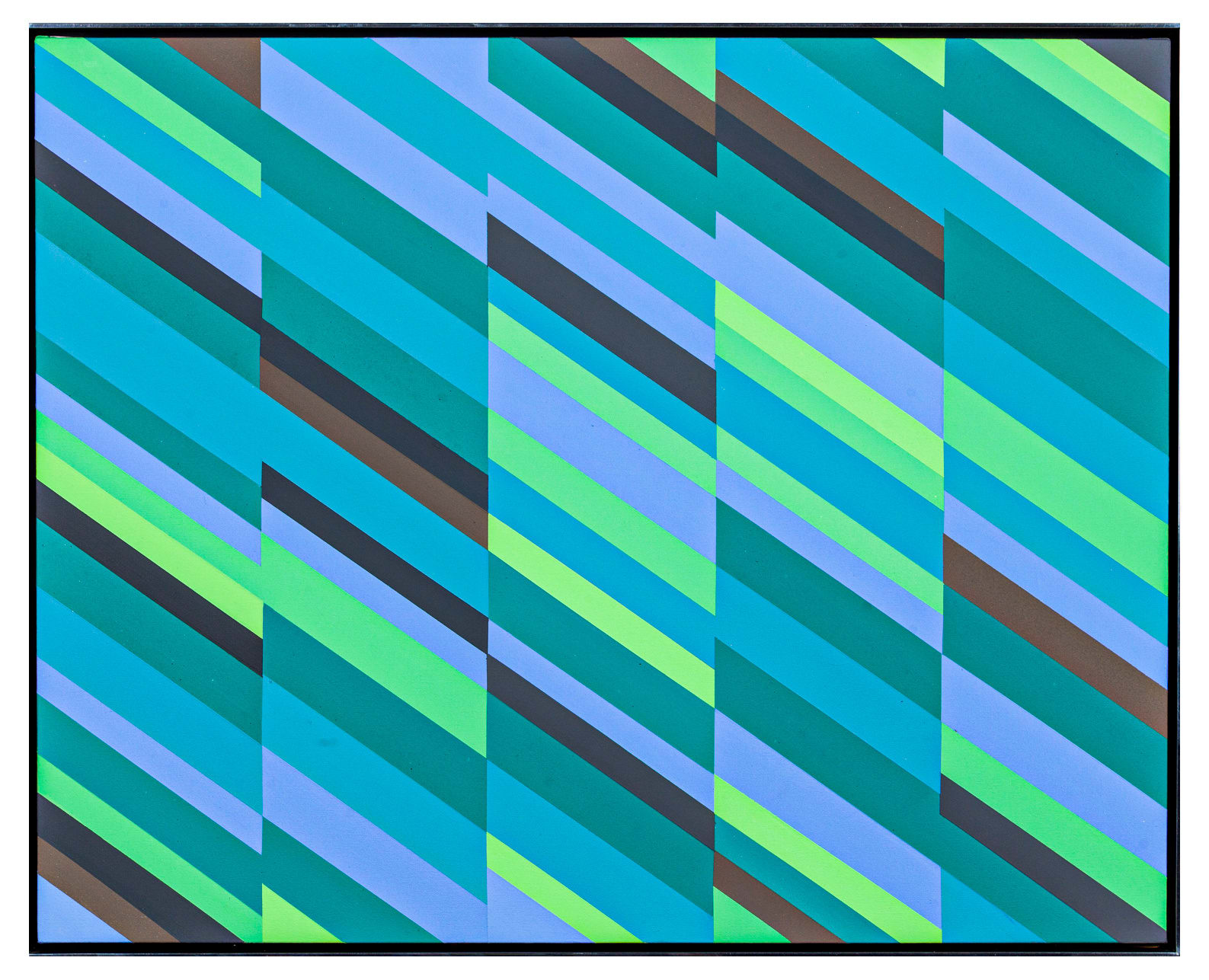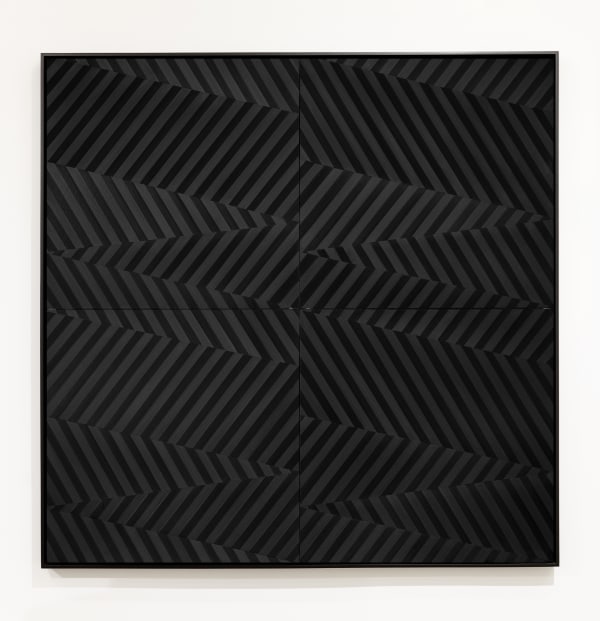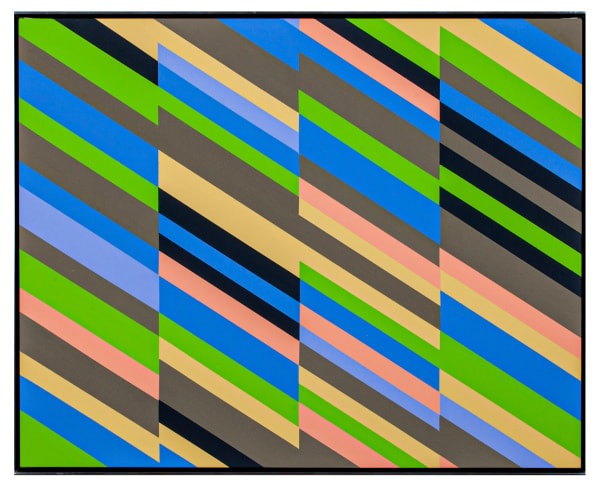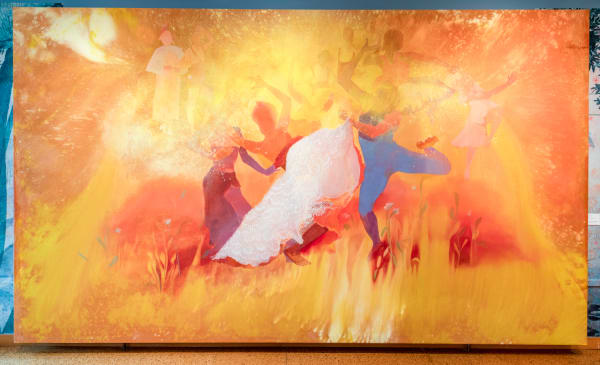James Little USA, b. 1952
Checkered Past, 2017
Raw pigment on canvas
33 1/4 x 41 1/2 x 1 1/2 in
84.5 x 105.4 x 3.8 cm
84.5 x 105.4 x 3.8 cm
7969
Further images
Checkered Past is a painting by 2022 Whitney Biennial artist James Little. Painted with raw pigment on canvas, the composition portrays five columns of diagonal color bars rendered in six...
Checkered Past is a painting by 2022 Whitney Biennial artist James Little. Painted with raw pigment on canvas, the composition portrays five columns of diagonal color bars rendered in six different hues. Little’s mastery of color relationships pulls the eye into an examination of how the same hue can appear to have a slightly different tonality depending on the other hues to which it is adjacent. The title coyly suggests notions of a mixed reputation, something dependent on perspective in much the same way as this painting. It also suggests Little’s affinity for art history, in particular his interest in the legacy of the grid within abstract art.
This painting belongs to Little’s Blue Slant series, which mobilize horizontally stacked columns of intersecting diagonal colorfields. Little’s Slants use the minimal visual tools of color, shape and pattern to create dynamic perceptual shifts that suggest movement and energy. The Slant series is unique among Little’s overall oeuvre, and yet is a definitive representation of the artist’s distinctive abstract aesthetic language, which is rooted in geometric shapes and patterns, flat surfaces, and emotive color relationships.
The Blue Slant series is also part of a larger series of paintings Little makes by layering raw, handmade pigments on canvas. Little creates these works slowly, applying multiple layers of pigment with small rollers until he achieves the desired purity of his handcrafted hues. It is important to Little that the painting is allowed to express small imperfections on the surface, such as scratches, raised ridges between the colorfield, or detritus encased in the paint, which serve to show the human presence of the artist's hand. The colors in the work shift dramatically according to the lighting, seeming to almost soak up the light in a bright space, and seeming in low light to glow.
Most painters paint with wet mediums that are made by mixing a dry pigment (think ground umber) with a wet binder (such as linseed oil). The pigment carries the color, while the binder suspends that color in a form that can be transferred onto a surface using a brush or other painting implement. There are some painters, however, who skip the binder and paint directly with the dry pigment. You can simply apply the dry pigment to a surface then coat it with some kind of clear sealer.
Raw pigment gives the painter more control over aesthetic issues. Raw pigments create a much more translucent layer than wet paint, which can be helpful for painters experimenting with underpainting effects and painters who are looking for different ways for their colors to react with light, and with each other. Raw pigments also create a texture that is much more earthy and organic looking than the smooth surface created by wet paint.
As a painter who wants as much control as possible over his materials and paintings, James Little is famous for hand making his own mediums. One way he achieves this is to paint with dry pigments; another way is to manufacture his own encaustics, by suspending his pigments in a melted wax binder.
This painting belongs to Little’s Blue Slant series, which mobilize horizontally stacked columns of intersecting diagonal colorfields. Little’s Slants use the minimal visual tools of color, shape and pattern to create dynamic perceptual shifts that suggest movement and energy. The Slant series is unique among Little’s overall oeuvre, and yet is a definitive representation of the artist’s distinctive abstract aesthetic language, which is rooted in geometric shapes and patterns, flat surfaces, and emotive color relationships.
The Blue Slant series is also part of a larger series of paintings Little makes by layering raw, handmade pigments on canvas. Little creates these works slowly, applying multiple layers of pigment with small rollers until he achieves the desired purity of his handcrafted hues. It is important to Little that the painting is allowed to express small imperfections on the surface, such as scratches, raised ridges between the colorfield, or detritus encased in the paint, which serve to show the human presence of the artist's hand. The colors in the work shift dramatically according to the lighting, seeming to almost soak up the light in a bright space, and seeming in low light to glow.
Most painters paint with wet mediums that are made by mixing a dry pigment (think ground umber) with a wet binder (such as linseed oil). The pigment carries the color, while the binder suspends that color in a form that can be transferred onto a surface using a brush or other painting implement. There are some painters, however, who skip the binder and paint directly with the dry pigment. You can simply apply the dry pigment to a surface then coat it with some kind of clear sealer.
Raw pigment gives the painter more control over aesthetic issues. Raw pigments create a much more translucent layer than wet paint, which can be helpful for painters experimenting with underpainting effects and painters who are looking for different ways for their colors to react with light, and with each other. Raw pigments also create a texture that is much more earthy and organic looking than the smooth surface created by wet paint.
As a painter who wants as much control as possible over his materials and paintings, James Little is famous for hand making his own mediums. One way he achieves this is to paint with dry pigments; another way is to manufacture his own encaustics, by suspending his pigments in a melted wax binder.
Exhibitions
Whitney Biennial 2022 Quiet As Its Kept 2022. Whitney Museum of Art, New York, NY, USA; Abstraction and Social Critique 2022. Kavi Gupta | Washington Blvd, Chicago, IL, USA;
Share
- X
- Tumblr
Related artworks
-
 James LittleBlack Star, 2015Oil and wax on linen72 x 72 x 1 1/2 in
James LittleBlack Star, 2015Oil and wax on linen72 x 72 x 1 1/2 in
182.9 x 182.9 x 3.8 cm -
 James LittleGorilla, 2019Oil and wax on linen72 x 72 x 1 1/2 in
James LittleGorilla, 2019Oil and wax on linen72 x 72 x 1 1/2 in
182.9 x 182.9 x 3.8 cm -
 James LittleRecognizable Difference, 2016Raw pigment on canvas33 1/4 x 41 1/2 x 1 1/2 in
James LittleRecognizable Difference, 2016Raw pigment on canvas33 1/4 x 41 1/2 x 1 1/2 in
84.5 x 105.4 x 3.8 cm -
 Firelei BáezMagnitude and Bond, 2018Acrylic/Oil on canvas, Custom Made, Foldable Aluminum Stretchers108 x 192 in
Firelei BáezMagnitude and Bond, 2018Acrylic/Oil on canvas, Custom Made, Foldable Aluminum Stretchers108 x 192 in
274.3 x 487.7 cm



















